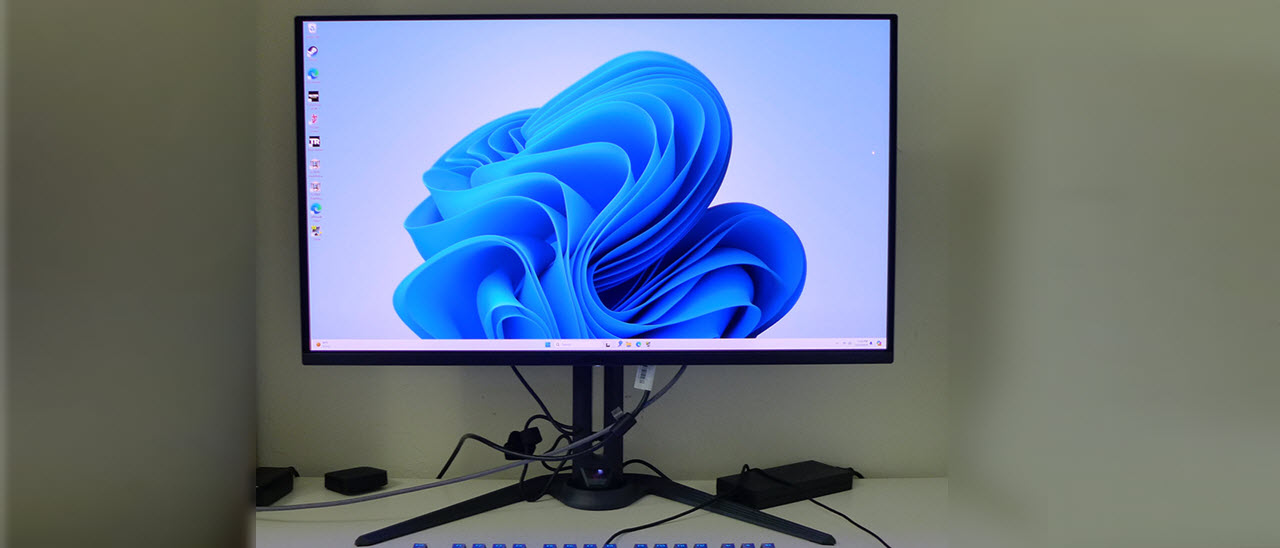Tom's Hardware Verdict
Aside from SDR gamma that’s a bit light, the FO32U2P has no real flaws. It serves well for gaming, movies and workday tasks with a gorgeous image, premium video processing, high-end build quality and elegant styling.
Pros
- +
Stunning image with high contrast and saturated color
- +
Accurate without calibration
- +
Adjustable HDR image
- +
Top-shelf video processing with blur-free motion over 200fps
- +
Premium build quality
Cons
- -
Light gamma in SDR mode
Why you can trust Tom's Hardware
I’ve been reviewing a lot of OLED monitors lately, mainly of the 27-inch QHD 240 Hz variety. They provide astounding performance and a stunning image, but I know many buyers want 4K resolution. That means fewer choices, but some of the best 4K gaming monitors are out there, mostly running at 144 to 160 Hz. When you run below 200 fps, there is some motion blur, and those extra pixels won’t help, even if you have a stout video card capable of driving 8.3 mega-pixels at 144 fps.
Now that you’ve been warned, prepare for 4K at 240 Hz. There are few choices here, but if you have the system to run 4K at 240fps, you can have a truly wonderful gaming experience. Recently, I checked out the Alienware AW3225QF, and now I have Aorus’ FO32U2P, part of Gigabyte’s premium line of gaming hardware. Let’s take a look.
Gigabyte Aorus FO32U2P Specs
| Panel Type / Backlight | Quantum Dot |
| Row 1 - Cell 0 | Organic Light-Emitting Diode (QD-OLED) |
| Screen Size / Aspect Ratio | 32 inches / 16:9 |
| Max Resolution and Refresh Rate | 3840x2160 @ 240 Hz |
| Row 4 - Cell 0 | FreeSync: 48-240 Hz |
| Row 5 - Cell 0 | G-Sync Compatible |
| Native Color Depth and Gamut | 10-bit / DCI-P3 |
| Row 7 - Cell 0 | HDR10, DisplayHDR 400 |
| Response Time (GTG) | 0.03ms |
| Brightness (mfr) | 250 nits SDR |
| Row 10 - Cell 0 | 1,000 nits HDR (3% window) |
| Contrast | Unmeasurable |
| Speakers | 2x 5w |
| Video Inputs | 1x DisplayPort 2.1 in |
| Row 14 - Cell 0 | 1x MiniDP 2.1 in |
| Row 15 - Cell 0 | 1x DisplayPort 1.4 out |
| Row 16 - Cell 0 | 2x HDMI 2.1, 1x USB-C |
| Audio | 3.5mm headphone output |
| Row 18 - Cell 0 | 3.5mm mic input |
| USB 3.2 | 1x up, 2x down |
| Power Consumption | 68w, brightness @ 200 nits |
| Panel Dimensions WxHxD w/base | 28.3 x 19-24.1 x 10 inches (718 x 483-612 x 254mm) |
| Panel Thickness | 2.2 inches (57mm) |
| Bezel Width | Top: 0.4 inch (9mm) |
| Row 24 - Cell 0 | Sides: 0.5 inch(12mm) |
| Row 25 - Cell 0 | Bottom: 0.7 inch (17mm) |
| Weight | 18.7 pounds (8.5kg) |
| Warranty | 3 years |
An OLED panel running at 240 Hz is where it’s at for the smoothest possible motion processing and low input lag. QHD has plenty of pixel density in the 27-inch size, 109ppi, but 4K has more. The FO32U2P is a 32-inch flat 16:9 QD-OLED panel with 144 ppi.
A Quantum Dot layer gives the FO32U2P a huge color gamut. Gigabyte claims 99% coverage of DCI-P3, but I measured almost 108%. This is a lot of color and it’s easy to see the difference between it and more typical wide-gamut screens that cover around 90%. Surprisingly, it doesn’t have the largest gamut I’ve measured, more on that later, but it’s up with the very best.
Color accuracy is assured by an individual factory calibration with a data sheet included in the box. My sample met its data points and can indeed be used without adjustment. I found a small gamma issue, which I’ll detail in the test notes, but the FO32U2P has no problem keeping up with its competition.
In the brightness department, it has typical performance with 265 nits peak white for SDR and 457 nits in HDR mode. It won’t hit the searing 1,500-nit highlights of a Mini LED monitor, but among OLEDs, it is no brighter or dimmer than average. Of course, it has the same infinite blacks as the competition, so contrast is better than any LCD.
With 240 Hz available, video processing is superb. OLED extracts smoother motion from a given refresh rate than LCD, so you don’t need super high speeds to achieve perfect motion resolution. The FO32U2P’s 4K resolution means you’ll need a top-of-the-line video card to crack 200fps, which is the point where blur is absent. Adaptive-Sync is supported here for both FreeSync and G-Sync platforms. The FO32U2P has not been certified by Nvidia, but I have had no issues running G-Sync at any time.
Get Tom's Hardware's best news and in-depth reviews, straight to your inbox.
Physically, the FO32U2P stands out thanks to elegant styling. It follows the format of a thin panel with a component bulge in the back. The panel part is just four millimeters thick with a metal backing. The bulge is relatively slim and is set off with LED lighting and a sculpted geometric shape. The stand is premium as well.
The feature list includes everything in Gigabyte’s stable, meaning plenty of play aids like aiming points, sniper mode, night vision, and timers. You get an on-screen dashboard to monitor nine parameters in real time. The OSD includes an extensive set of OLED care features to prevent burn-in. Nothing is left out here, and the price of $1,200 reflects that. While not a value option, the FO32U2P delivers a lot of goodness for the money.
Assembly and Accessories
The FO32U2P ships in a clamshell box that opens to reveal blocks of crumbly foam protecting the contents. The base and upright assemble with a captive bolt and the panel snaps on. The screen is protected by thick film, so shipping damage is highly unlikely. The external power supply includes cords for three different countries’ electrical standards. For video, you get HDMI, DisplayPort, and USB-C cables. Peripherals are supported by a USB-A/B cable.
Product 360
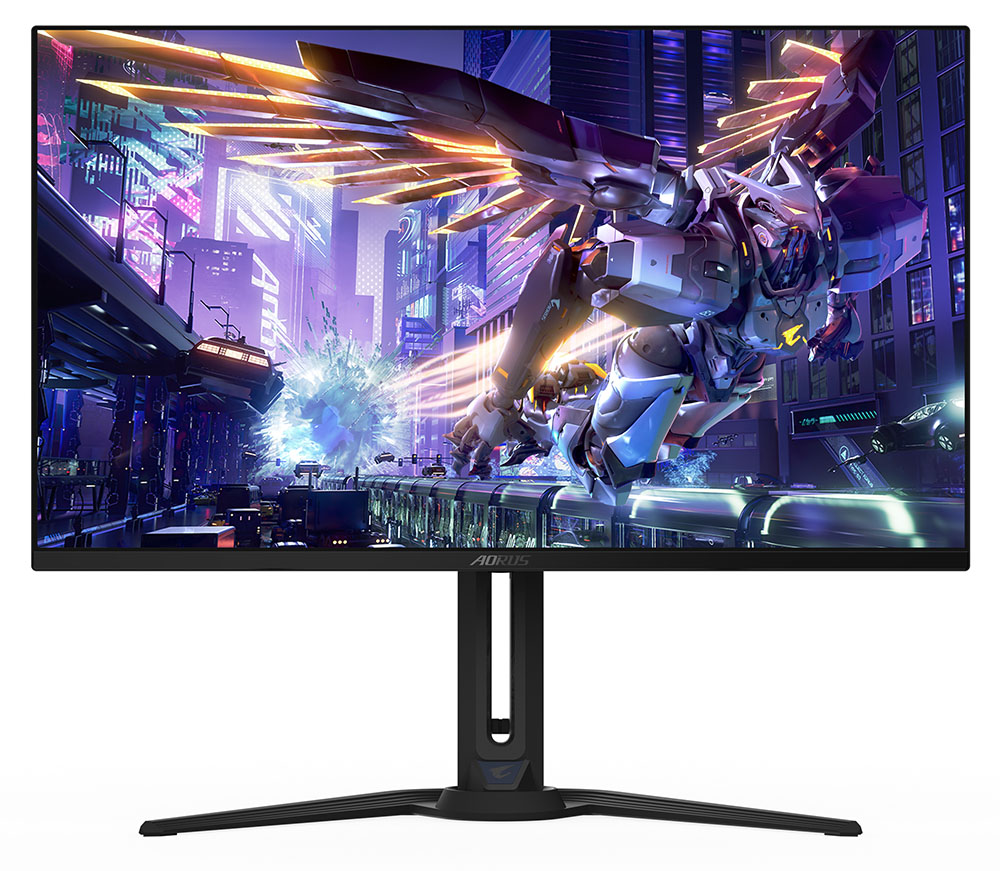

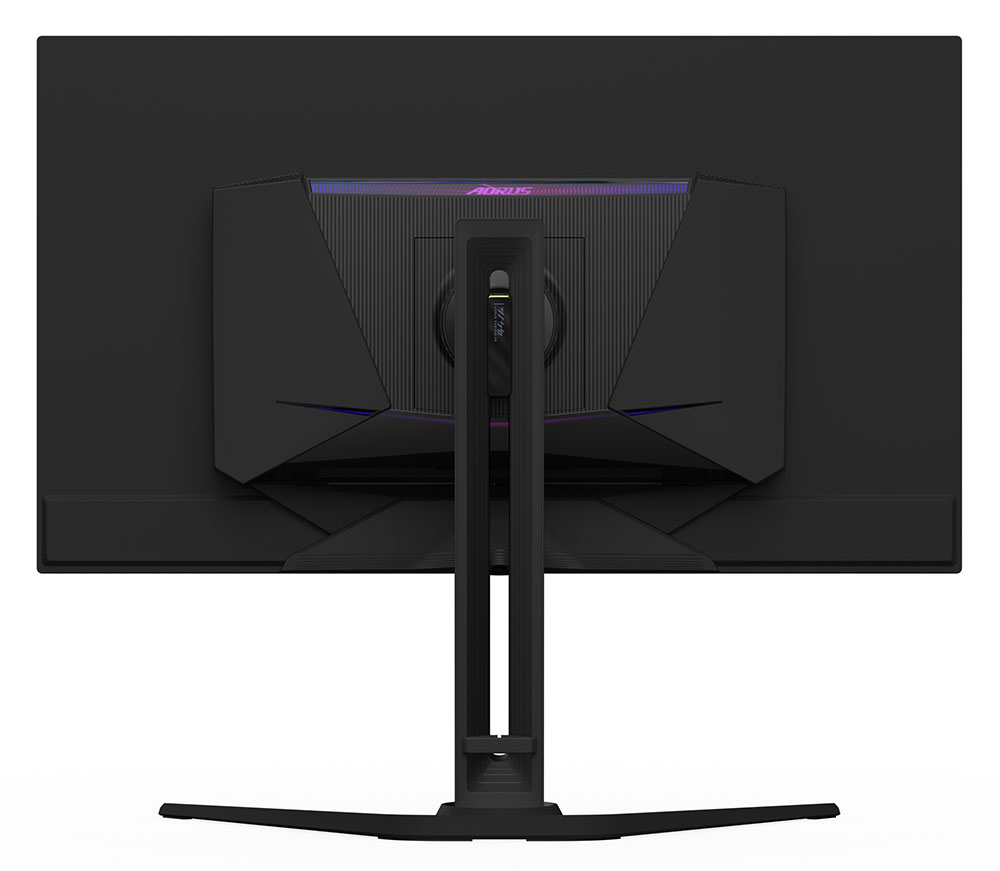

The FO32U2P has a minimalistic look in front, with just a small Aorus logo on the bottom bezel. The rest of the frame is flush and quite narrow. When the image is visible, the border is barely noticeable. There are no controls on the front and the power LED is very small and doesn’t glow too brightly.
You can see the panel-on-bulge styling from the back and sides I spoke of earlier. This is unique to OLEDs. The panel part is just four millimeters thick, while the bulge extends depth to 2.2 inches, thinner than the average 32-inch monitor. The bulge has a unique-looking LED strip on top with another Aorus logo at its center. Molded-in textures and sculpted lines create a unique blend of elegance and entertainment. The FO32U2P is clearly aimed at gamers but will work in an enterprise setting, too.
The stand is very stout and solid, with a generous 5.1-inch height adjustment. You also get 5/20 degrees tilt, 20 degrees swivel, and a 90-degree portrait mode. Movements are smooth and firm, with no play at all. The cast aluminum base is finished in a matte black crinkle coat and is more than up to the task of keeping the FO32U2P in place. The upright is slender, with a cutout in the middle and a cable management clip at the bottom.
The jack panel is in the usual up-and-under center spot and features two DisplayPort 2.1 inputs, one standard and one mini. It should be noted that the current crop of GeForce RTX 4090 video cards tops out at DP 1.4a. The FO32U2P includes a version switch in the OSD to address this. There is also a DP 1.4 output for daisy chaining, meaning you don’t have to run multiple video cables to your PC. Additional inputs include two HDMI 2.1 and a USB-C, which support DP functions and provide 65 watts of power. USB 3.2 is covered by one upstream and two downstream ports along with KVM options in the OSD. The internal speakers play cleanly with five watts of power, and you get a 3.5mm headphone jack and a 3.5mm microphone input.
OSD Features
The FO32U2P’s OSD is summoned by a press and up-click of the joystick. Two additional buttons flank it and can be programmed for a variety of different functions for quick access. The joystick directionals take you straight to inputs, volume and picture mode selection.
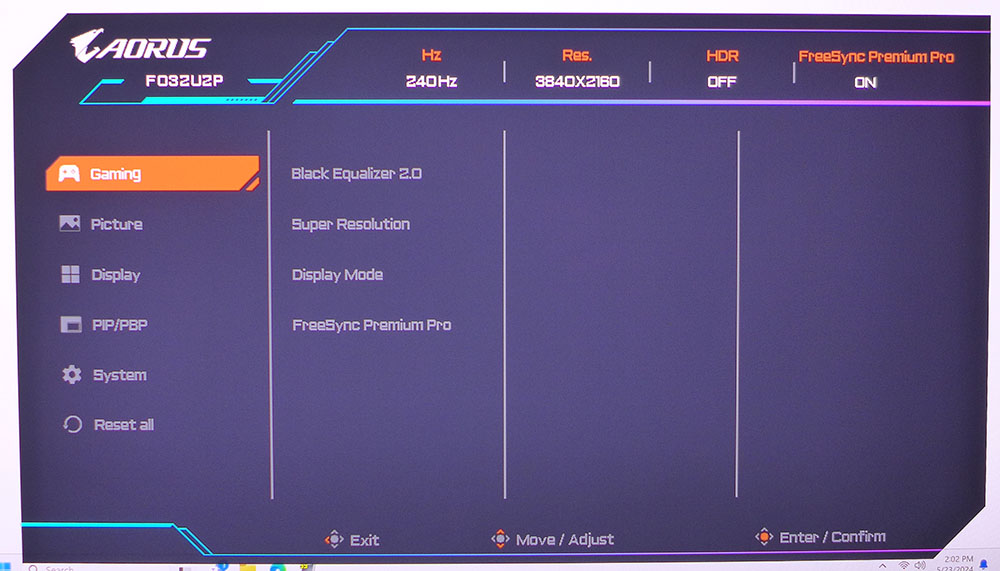






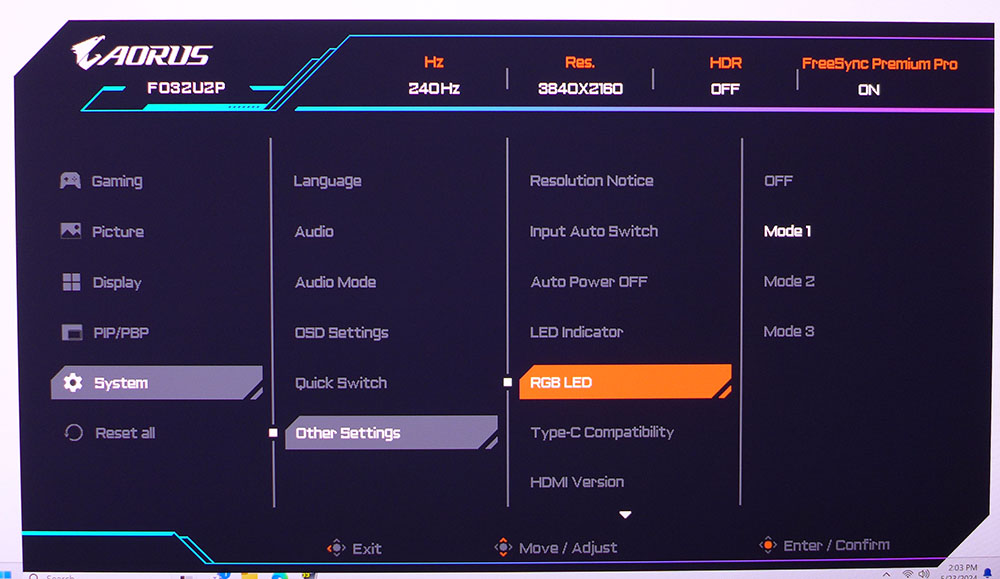
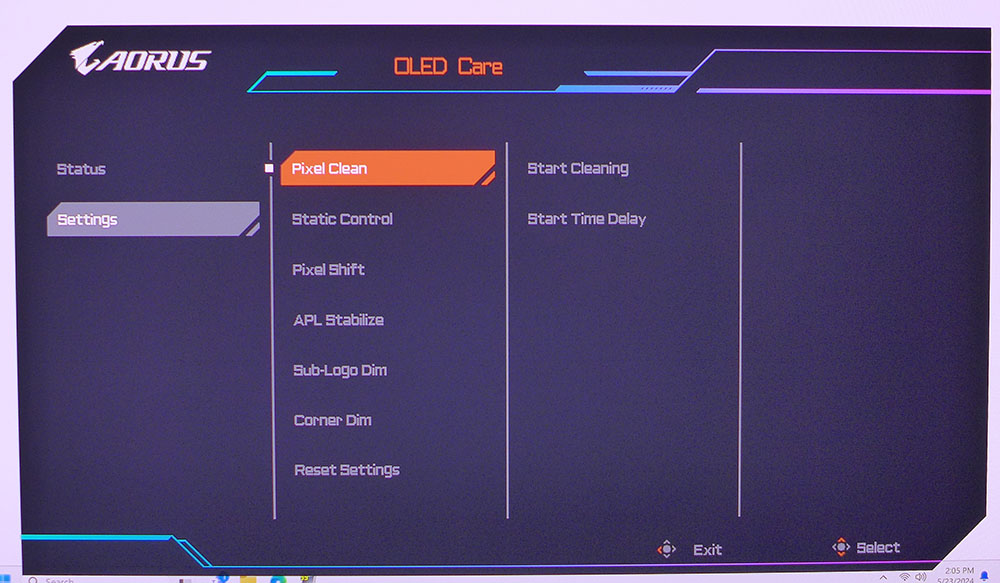
The first menu is Gaming but since nearly all the play aids are in a separate Game Assist section, the only things here are an Adaptive-Sync toggle, black equalizer to enhance shadow detail, super resolution edge enhancement and aspect ratio options.
The fun starts in the Picture menu where you get 10 image modes. The default is Eco, but I recommend using Standard or Custom since it is brightness limited. The latter includes calibration controls like gamma presets, color temps, color management and gamut selection. I recommend leaving that last one on Native. The other options gray out key image controls. The downside is that you’ll be using the full native gamut which covers 107% of DCI-P3 for all content. But there is an accurate sRGB picture mode if you want the smaller color space.
The KVM feature gets its own menu with easy setup through a wizard. It lets you bind a single set of peripherals to multiple systems. The FO32U2P has extensive PIP and PBP options that let you view two video sources at once.
The LED lighting is found across the top of the component bulge in the back and features three different effects. The first one reminded me of the Cylons from the original Battlestar Galactica with its back-and-forth light pulses that cycle through the full color spectrum. If the lights distract, you can turn them off.
The FO32U2P has a huge list of OLED care options to prevent burn-in. You can run a pixel clean procedure, recommended every four hours, that wipes the screen to equalize pixel usage. It’s best to run when you’re not using the monitor. The significant option here is APL Stabilize. This is a form of variable brightness with three levels of intensity. On Low, there is no change in brightness for dark or light content. I verified this in testing. It is the best way to use the FO32U2P because the image remains stable. The two higher settings change brightness globally and you’ll see some shift during gameplay.
Game Assist



Pressing the joystick and clicking right brings up the Game Assist menu. This menu is unique to Gigabyte monitors and has a huge array of features to aid gameplay. You can put a data window at the top of the screen that runs countdown and elapsed time, plus a frame rate indicator. Visual aids include aiming points, four different sniper mode magnifications, and night vision.
The Dashboard is activated with a USB connection and Gigabyte’s OSD Sidekick app. Once installed, you can monitor CPU and GPU parameters in real-time through an on-screen window. It’s fairly large and will cover about 10% of the screen in a corner of your choosing. It can be shrunk by turning off some of the nine available info fields.
Gigabyte Aorus FO32U2P Calibration Settings
The FO32U2P comes out of the box in Eco mode. It’s color accurate, but brightness is limited, peaking at around 150 nits. You can use either Standard or Custom to unlock the full luminance range. Both can be calibrated, so I went for Custom. The Normal color temp hits the 6500K white point, but I found a small improvement with the User Define option and its RGB controls which are precise. The gamma presets are accurately labeled but tracking showed some too-bright values in the middle and upper steps. I’ll show you those results on page four. If you want sRGB color, choose that picture mode. The Color Space option should be left on Native. The Adobe and Display P3 choices gray out all other picture controls. My SDR settings are below should you wish to try them.
In HDR mode, you get five new presets. HDR is the default and best choice. Three of them include luminance and color adjustments to help tailor the image to your liking. This is rare among HDR monitors. Most offer no options for HDR image control.
| Picture Mode | Custom |
| Brightness 200 nits | 90 |
| Brightness 120 nits | 51 |
| Brightness 100 nits | 41 |
| Brightness 80 nits | 31 |
| Brightness 50 nits | 16 (min. 20 nits) |
| Contrast | 50 |
| Gamma | 2.2 |
| Color Temp User | Red 97, Green 98, Blue 100 |
Gaming and Hands-on
Fortunately, I have a GeForce RTX 4090-based PC to test gaming monitors. The FO32U2P, with its 4K resolution and 240 Hz, used every ounce of that card’s capabilities. I could feel waves of heat blowing from the tower PC as I played. But the benefit was well worth it. Nothing is as sharp as 4K and motion resolution was off-the-chain good, as in perfect. Moving objects and backgrounds retained every scrap of detail. G-Sync worked perfectly, though you’d unlikely see a frame tear at speeds over 200 fps. I never dropped below 230 fps during my gaming sessions!
The FO32U2P offers multiple HDR modes, and I experimented a bit with it. Doom Eternal offers extensive in-game adjustments, so I tweaked them in the default HDR mode but could never find the right balance of settings. I tried HDR Vivid, which adds monitor settings to the mix and achieved the image I was looking for. It has multiple luminance sliders and a color enhancer too. All of these came into play. I could make highlights brighter and more detailed while retaining clear and deep blacks and supremely saturated color. The FO32U2P’s extra HDR adjustments are a very powerful feature that you won’t find anywhere else.
Since the FO32U2P is flat and 16:9, it is perfectly suited for work. You won’t sacrifice anything by using it for productivity. Its size is perfect for multi-tasking but not so big that you can’t focus on what you need to. TV-sized monitors are great for gaming but are too big for Word and Excel. The FO32U2P is an ideal balance between work and play.
The image is stunning in SDR and HDR modes. Though I noted light gamma in testing, this doesn’t detract from the image. When comparing the FO32U2P next to an Alienware AW3225QF, it had slightly less impact. But viewed alone, there was no perception that it was anything but gorgeous to look at. I’m spoiled by OLEDs and if you buy one, you will be too.
Physically, the FO32U2P has no negatives. The stand is superb, build quality is high-end, and controls are easy and intuitive. The light show is cool, with its effects playing on my back wall. The OSD was easy to navigate. When I saw that you could make the OSD jumbo-sized, I thought I might find a remote in the box, but there was none. 32 inches is on the edge for viewing distance, so a remote isn’t really needed. But it would be nice to have when watching movies where I would sit back a bit more.
Takeaway: The FO32U2P is a gorgeous monitor even when turned off. With elegant styling and a stunning OLED picture, I would happily use it for work and play. It has decent audio and is a pleasure to game on with its blur-free motion and quick response. The additional HDR adjustments make it a breeze to tweak to your liking. There is nothing it can’t do well.
MORE: Best Gaming Monitors
MORE: How We Test PC Monitors
MORE: How to Buy a PC Monitor
Current page: Features and Specifications
Next Page Response, Input Lag, Viewing Angles and Uniformity
Christian Eberle is a Contributing Editor for Tom's Hardware US. He's a veteran reviewer of A/V equipment, specializing in monitors. Christian began his obsession with tech when he built his first PC in 1991, a 286 running DOS 3.0 at a blazing 12MHz. In 2006, he undertook training from the Imaging Science Foundation in video calibration and testing and thus started a passion for precise imaging that persists to this day. He is also a professional musician with a degree from the New England Conservatory as a classical bassoonist which he used to good effect as a performer with the West Point Army Band from 1987 to 2013. He enjoys watching movies and listening to high-end audio in his custom-built home theater and can be seen riding trails near his home on a race-ready ICE VTX recumbent trike. Christian enjoys the endless summer in Florida where he lives with his wife and Chihuahua and plays with orchestras around the state.
-
OL-US I have had this monitor (FO32U2P) for 1.5 years now.Reply
At first there were known issues with black screens during games. I sent it to Gigabyte Poland EU for repair via RMA. Received it in a couple of weeks, but when trying to update the firmware from F02 to F06, the monitor started showing only white. Ok, I sent it back via RMA again.
Received it back today after the second repair. And what do I see? They sent me my monitor with a motherboard from a cheaper monitor (FO32U2). Damn. Either these are unqualified repairmen or this is an attempt at fraud. I wrote to them demanding a refund (this is the third warranty repair) and will most likely contact lawyers for court.
I do not recommend Gigabyte and its service, people.
https://www.reddit.com/r/OLED_Gaming/comments/1mo4j4b/problems_with_gigabyte_aorus_fo32u2p/
